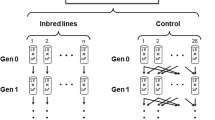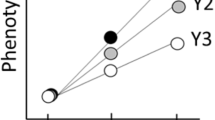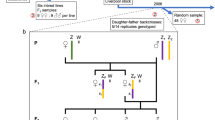Abstract
THODAY and Boam1–3 have shown that disruptive selection can render a population of Drosophila melanogaster effectively polymorphic for factors affecting sternopleural chaeta number. That such selection might produce polymorphism was predicted by Mather4. Thoday and Boam3 found that the polymorphism they had established depended upon a second-chromosome giving low chaeta numbers and a third-chromosome giving high chaeta numbers, each of these being balanced against chromosomes giving intermediate chaeta numbers. We have carried out further experimental analysis of second-chromosomes extracted from these polymorphic populations with remarkable results which, though there is much further work to do, seem to us worth immediate report.
This is a preview of subscription content, access via your institution
Access options
Subscribe to this journal
Receive 51 print issues and online access
$199.00 per year
only $3.90 per issue
Buy this article
- Purchase on Springer Link
- Instant access to full article PDF
Prices may be subject to local taxes which are calculated during checkout
Similar content being viewed by others
References
Thoday, J. M., Nature, 181, 1124 (1958).
Thoday, J. M., Heredity, 13, 187 (1959).
Thoday, J. M., Boam, T. B., Heredity, 13, 205 (1959).
Mather, K., Evolution, 9, 52 (1955).
Mather, K., Biol. Revs., 18, 32 (1943).
Author information
Authors and Affiliations
Rights and permissions
About this article
Cite this article
GIBSON, J., THODAY, J. Recombinational Lethals in a Polymorphic Population. Nature 184, 1593–1594 (1959). https://doi.org/10.1038/1841593a0
Issue Date:
DOI: https://doi.org/10.1038/1841593a0
This article is cited by
-
Complex polymorphisms where the coupling and repulsion double heterozygote viabilities differ
Heredity (1963)
-
An Apparent 20 Map-Unit Position Effect
Nature (1962)
-
Effects of disruptive selection
Heredity (1962)
-
The Evolution of Overdominance: Natural Selection and Heterozygote Advantage
Nature (1961)
-
Effects of disruptive selection
Heredity (1961)
Comments
By submitting a comment you agree to abide by our Terms and Community Guidelines. If you find something abusive or that does not comply with our terms or guidelines please flag it as inappropriate.



